Which System Includes The Skin, Hair, And Nails And Provides Protection From The Environment?
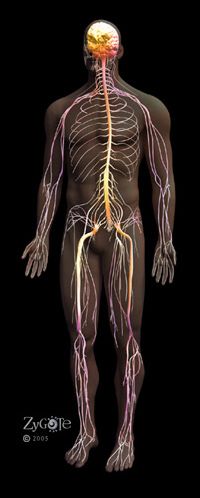
Nervous organization. Courtesy of 3DScience.com
As commonly defined, the human body is the physical manifestation of a man, a collection of chemical elements, mobile electrons, and electromagnetic fields present in extracellular materials and cellular components organized hierarchically into cells, tissues, organs,and organ systems. The human body as an integrated whole is a highly dynamic system maintaining its form and function even as individual cells are routinely dismantled and replaced with newly constructed ones.
Several fields are involved in the study of the human body. Beefcake focuses on the structure and form of the human body by describing, for instance, organs and organ systems. Human being physiology, a specialized field inside physiology, studies the performance of the homo trunk, including its systems, tissues, and cells. The study of tissues is the focus of histology, and the written report of cells is part of cytology.
Contents
- 1 Chemical elements
- 2 Cells
- 3 Tissues
- 4 Organs
- 5 Major systems of the human trunk
- 6 External features
- 7 Internal organs
- 8 The man body in religious and philosophical context
- viii.ane The Body in Chinese medicine
- 8.ii Energy vortices in the human body
- ix Then much more a car
- 10 References
- 11 Credits
The human body is an intricate organism, with cells, tissues, organs, and systems working together in remarkable harmony. In Eastern medicine, the meaning of the term human body is extended to include networks of immaterial mental or energetic pathways. This leads towards a holistic understanding of the "mind-body" human relationship.
Chemical elements
The most common chemical elements in the human body are oxygen (65 percent by mass), carbon (18 percent), hydrogen (10 percentage), nitrogen (iii pct), calcium (1.v percent), and phosphorus (1 percentage) (Harper, Rodwell, and Mayes 1977). These 6 elements brand up 99 percent of the mass of the human body. Potassium (0.35 percent), sulfur (0.25 percent), sodium (0.15 percent), and magnesium (0.05 percent) are the next four most common elements. 10 elements but combine for well-nigh 0.7 pct of the human body's mass: iron, copper, zinc, selenium, molybdenum, fluorine, chlorine, iodine, manganese, and cobalt. Trace elements that have been identified include lithium, strontium, aluminum, silicon, lead, vanadium, arsenic, and bromine.
The well-nigh mutual chemical compound in the human body is water, with cells having betwixt 65 pct and 90 pct by weight. 4 other common compounds are carbohydrates (such as glucose or starch), lipids (fats), nucleic acids, and proteins. These last four all include the element carbon.
Cells
The average developed human trunk is estimated to accept ten trillion to one hundred trillion cells. These range in size from a sperm prison cell, which is the smallest, to the egg cell, which is the largest. The sperm head is about 2.5 to iii.v microns broad and 5 to 7 microns long, with a tail nigh l to lxxx microns long. The egg cell is nearly 60 microns in diameter. Although muscle cells may be considered larger, they are multinuclear and represent the fusion of many individual cells. Nerve cells are large because of the axons, simply the actual cell body is smaller than the egg.
There are a wide variety of types of cells, and they differ in size, shape, and function. Among the types of cells are bone cells, blood cells, nervus cells, musculus cells, stomach cells, and so along. Red blood cells acquit oxygen, bone cells form the skeleton of the body, nervus cells carry electrical signals, and musculus cells move the basic. Stomach cells secrete acids to assimilate food, while cells in the intestines absorb nutrients.
Tissues
Tissues are collections of similar cells that perform a specialized part. The human body has four chief tissue types:
- Muscle tissue. Muscle tissue, which is composed of musculus cells and has the power to contract and relax, makes upwards the body's muscles. There are approximately 650 skeletal muscles in the human trunk. These muscles are of three general types: smooth musculus (or "involuntary muscle"), such as establish in the intestine and throat; cardiac muscle, an involuntary muscle found but in the eye; and skeletal muscle, a voluntary muscle anchored by tendons to bones and used for skeletal movement. All iii types of muscle use actin and myosin to produce contraction and relaxation, and thus movement. Do does non increment muscles, but rather the size of the muscle cells.
- Nervus tissue. Nerve tissue is composed of ii cell types: neurons and glial cells. Neurons take excitable membranes that allow them to generate and transmit electrical signals. They are found in the peripheral nervous system, the spinal string, and the brain. Glial cells are not-neuronal cells that form myelin, provide support and diet, and help in signal transmission. The human being encephalon is estimated to accept fifty times as many glial cells as neurons.
- Epithelial tissue. Epithelial tissue is composed of tightly packed cells that grade continuous sheets and serve every bit linings for unlike parts of the body. Epithelial tissues line organs, helping to protect and separate them. Epithelial tissue lines both the outside of the body (peel) and the within (the mouth, stomach, intestine, lungs, reproductive and urinary tract, endocrine glands, exocrine glands, etc.).
- Connective tissue. Connective tissue is composed of a diverseness of types of cells and generally provides the human being body with support, protection, and structure. Examples include cartilage, tendons, inner layers of skin, bone, ligaments, lymph, and fat tissue. Blood is as well considered a connective tissue. Connective tissues are surrounded by, or embedded in, a matrix, that can exist solid, semisolid, or even liquid. Blood is surrounded by a liquid matrix, and fat cells by a semisolid matrix. Bone, or osseous tissue, contains specialized cells (osteocytes) within a mineralized extracellular matrix, aiding the bone'south function as connective tissue. Fibrous strands of the protein collagen frequently provide strength to connective tissue.
Organs
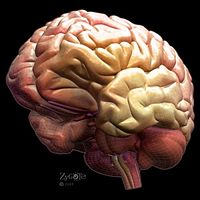
Brain. Courtesy of 3DScience.com
An organ is a grouping of two or more dissimilar kinds of tissues that work together to perform a specific function or group of functions. Examples of organs include the heart, lungs, brain, eye, stomach, spleen, pancreas, kidneys, liver, intestines, uterus, float, and so forth.
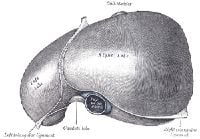
The liver is the largest internal organ of the man torso. The skin is the largest human organ overall.
The largest organ in the human body is the skin. Covering the entire body, even the eyes, which have a transparent layer of skin called the conjunctiva, the skin offers protection from water, air, sunlight, injury, dirt, chemicals, and microorganisms. The skin also helps to regulate temperature; contains nerves for awareness to touch and temperature; and holds fluids inside the body. Made up by iii layers of tissue—the height epidermis, the inner dermis, and the deepest layer of subcutaneous fatty tissue—the pare of an average adult covers an area of about 22 square anxiety, and varies in thickness depending on the function of the body covered. Fingernails and toenails are composed of dead cells from the epidermis, and hair is also modified epidermis.
The largest organ inside the human body is the liver. The liver in an adult typically weighs between 1.0 and 2.5 kilograms (two.ii to 5.five pounds). The liver plays a major office in metabolism and has a number of functions in the body including drug detoxification, glycogen storage, and plasma protein synthesis. Information technology likewise produces bile, which is important for digestion.
Major systems of the human body
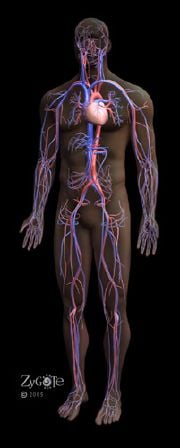
Circulatory system. Courtesy of 3DScience.com
A group of organs functioning as a unit is called a organisation, or organ system. For instance, the breadbasket, pocket-size intestine, liver, and pancreas are part of the digestive system, and the kidneys, bladder, and connecting tubes constitute the urinary arrangement.
The following are the major systems of the homo torso.
- Cardiovascular system. The cardiovascular system, or circulatory organization, is an organ organisation that moves substances to and from cells, such equally transporting oxygen, nutrients, and waste materials. The man circulatory arrangement consists of the heart, a network of blood vessels, and blood.
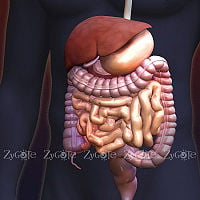
Digestive system. Courtesy of 3DScience.com
- Digestive system. The digestive organisation, noted above, breaks down nutrient into molecules that the body can use. The alimentary canal, or digestive tract, begins at the mouth and winds through the esophagus, breadbasket, small intestine, and large intestine, until the anus. The digestive system also includes the liver, located most the stomach in the abdominal cavity. The liver is vital for digesting fats by secreting bile, an emulsifying agent that breaks downward fat globules into pocket-size droplets. The gallbladder stores and concentrates the bile. The pancreas, also part of the digestive system, secretes pancreatic fluid, which take digestive enzymes for breaking down nutrients.
- Endocrine organization. The endocrine arrangement is a command organization that transmits chemical letters inside the torso using hormones, which are chemicals that are produced in 1 part of the body to touch cells in another part of the body. Major endocrine glands include the pineal gland, pituitary gland, thyroid gland, thymus, adrenal gland, and gonads (the ovary in females, and testis in males). There are likewise endocrine tissues in such organs as the brain, kidneys, stomach, and pancreas that produce hormones.
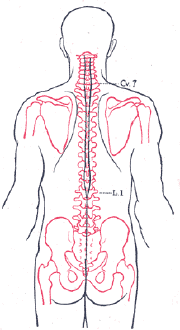
- Immune system. The allowed system involves organs and specialized cells that protect the body against pathogens, such as bacteria and viral infections. This system includes barriers to infection, such as skin and the mucus coating of the gut and airways; phagocytic cells that tin ingest and digest foreign substances; and anti-microbrial proteins. The stomach also secretes gastric acrid that helps to forestall bacterial colonization, while an adaptive immune system response helps to develop immunity confronting beingness infected twice past the same pathogen.
- Integumentary system. The integumentary system includes the peel, hair, nails, and peel glands and their products. This system helps in retention of torso fluids, sensing the person's surroundings, regulation of body temperature, emptying of waste matter products, and offer a protective barrier from the surroundings outside the body.
- Muscular organisation. The muscles, which are attached to the skeletal frame, cause the body to move.
- Skeletal system. The skeletal system or skeleton provides structural support and protection by means of bones. There are two basic parts, the centric skeleton (spine, ribs, sacrum, sternum, attic, and about fourscore basic in all) and the appendicular skeleton (basic of the artillery, pelvis, legs, and shoulders, totaling 126 basic in all). While at nascence a human has about 350 basic, the adult torso has about 206 bones, due to the fusing of some bones.
- Lymphatic system. The lymphatic system collects the blood plasma lost from the circulatory organisation as lymph and returns information technology to the circulatory system.
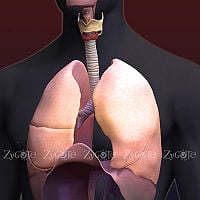
Respiratory organization. Courtesy of 3DScience.com
- Respiratory organization. The respiratory organization consists of the lungs, airways, and respiratory muscles that mediate the movement of gases (oxygen and carbon dioxide) into and out of the body. Involved in this organisation are external respiration (exchange of gases betwixt atmosphere and blood), and internal respiration (commutation of gases between cells of the body and the blood).
- Nervous arrangement. The nervous system functions in collecting, transferring, and processing information via cellular advice involving nervus cells, or neurons. The brain and spinal cord comprise the central nervous system and the fretfulness that radiate out to the remainder of the body comprise the peripheral nervous system. The human being encephalon contains approximately 100 billion neurons.
- Reproductive arrangement. The reproductive organisation involves a group of specialized organs that produce, store, and release gametes for reproduction.
- Urinary organisation. The urinary arrangement is the organ arrangement that produces, stores, and carries urine. This organisation includes two kidneys, ii ureters, the urinary bladder, two sphincter muscles, and the urethra.
External features
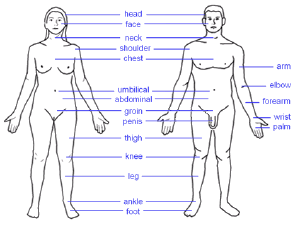
Common names of well known parts of the human body, from height to bottom:
- Peel
- Head – Forehead – Eye – Ear – Nose – Oral fissure – Tongue – Teeth – Jaw – Face – Cheek – Mentum
- Neck – Throat – Adam'south apple – Shoulders
- Arm – Elbow – Wrist – Hand – Fingers – Pollex
- Spine – Chest – Breast – Ribcage
- Abdomen – Abdomen button – Sex organs (Penis/Scrotum or Clitoris/Vagina) – Rectum – Anus
- Hip – Buttocks – Leg – Thigh – Knee – Calf – Heel – Ankle – Human foot – Toes
Internal organs
Common names of internal organs (in alphabetical order):
- Adrenal glands – Appendix – Float – Brain – Duodenum – Gall bladder – Center – Intestines – Kidney –Liver– Lungs – Ovaries – Pancreas – Parathyroid gland – Pituitary gland – Prostate gland – Spleen – Stomach – Thymus gland – Thyroid gland – Testicles – Womb
The human body in religious and philosophical context
Conventionally, definitions of the term human body treat the term equally synonymous with concrete body and material body. However, human beings define themselves not just in biological terms, merely also in social, spiritual, and religious terms. Information technology is not unusual, therefore, that the term "man body" sometimes may take on broader meanings than divers above. One concept is that humans take not simply a physical body with physical senses, just also an immaterial or spiritual trunk with spiritual senses. This spiritual body is considered to mirror the appearance of the concrete body, simply also exists after the death of the fabric form. An example of such is found in the Bible: "It is sown a physical torso, just it is raised a spiritual trunk. If there is a concrete trunk, there is besides a spiritual body" (1 Corinthians 15:44). (Run into human for an elaboration on this concept.)
In philosophical and spiritual terms, the term man torso is often used in context of "mind-torso unity" or "listen-torso disunity," in order to convey a separation between physical desires and spiritual aspirations, or as reflected in philosophy, the "mind-torso trouble."
The integration of the mental and physical aspects of the body has been developed systematically in Eastern medicine, both in Communist china and Republic of india. In these medical traditions, the body contains immaterial, energetic pathways that provide linkage between a person'south physical office and his or her mental or spiritual state.
The Body in Chinese medicine
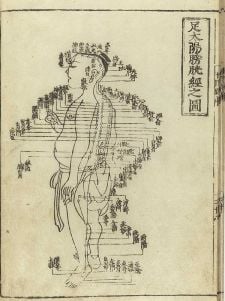
Acupuncture chart from Hua Shou (fl. 1340s, Ming dynasty, China). This prototype is from Shi si jing fa hui (Expression of the Fourteen Meridians) (Tokyo: Suharaya Heisuke kanko, Kyoho gan, 1716).
Chinese medicine is based on a model of the human body as a unmarried whole that involves several "systems of part" loosely associated with (merely non identified on a one-to-one footing with) physical organs. Some systems of function, such equally the "triple heater" (San Jiao, also called the "triple burner") have no respective physical organ, but rather, correspond the various jiaos or levels of the torso (upper, middle, and lower).
Disease is understood every bit a loss of residuum homeostasis betwixt the yin and yang energies among the several systems of function, and treatment of disease is attempted by modifying the activity of one or more systems of function through the action of needles, pressure, heat, etc., on small sensitive regions on the body surface, traditionally called "acupuncture points" in English language, or xue (穴, cavities) in Chinese. This is referred to every bit treating "patterns of disharmony."
The Chinese model of the human body identifies 12 primary and eight "extra" energy meridians running vertically, bilaterally, and symmetrically as channels corresponding to and connecting internally with ane of the 12 Zang Fu ("organs"). The meridians are in remainder with six yin and six yang channels.
10 of the main meridians are named later on organs of the torso (middle, liver, etc.), and the other two are named afterward so-called body functions (Heart Protector or Pericardium, and San Jiao). The meridians are capitalized to avoid confusion with a concrete organ (for example, "Heart meridian" as opposed to the "middle meridian"). The ii about important of the eight "extra" meridians are situated on the midline of the anterior and posterior aspects of the body and head.
In the Chinese model, wellness is achieved and maintained through the costless period of qi (a hard-to-translate concept that pervades Chinese philosophy and is commonly translated every bit "vital energy") throughout the body. Pain or illnesses are treated by attempting to remedy local or systemic accumulations or deficiencies of qi. Pain is considered to bespeak blockage or stagnation of the flow of qi, and an precept of the medical literature of acupuncture is "no hurting, no blockage; no blockage, no pain."
The movement of qi through each of the 12 channels follows both an internal and an external pathway. The external pathway is what is normally shown on an acupuncture chart and information technology is relatively superficial. All the acupuncture points of a aqueduct lie on its external pathway. The internal pathways are the deep course of the aqueduct where it enters the trunk cavities and related Zang-Fu organs. The superficial pathways of the 12 channels describe three complete circuits of the body.
Energy vortices in the human body
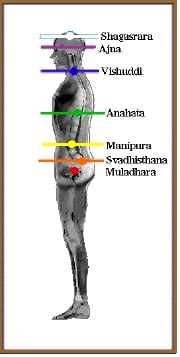
The chakras are identified in ancient Indian philosophies, and many others as well, as systemic vortices of free energy aligned in an ascending column from the base of the spine to the meridian of the head. In New Age practices, each chakra is ofttimes associated with a certain color. In various traditions, chakras are associated with multiple physiological functions, aspects of consciousness, and other distinguishing characteristics. They are often visualized every bit lotuses with a different number of petals in every chakra.
The chakras are thought to vitalize the concrete body and to be associated with interactions of a physical, emotional. and mental nature. They are considered loci of life energy or prana, also called shakti, qi (Chinese; ki in Japanese), coach-ha-guf (Hebrew), bios (Greek) and aether (English), which is thought to flow among them forth pathways called nadis. The part of the chakras is to spin and depict in this energy to proceed the spiritual, mental, emotional, and physical health of the torso in balance.
The growth of the New Historic period movement has sparked an increased interest in the Westward regarding chakras. Many in this movement bespeak to a correspondence between the position and role of the chakras and those of the glands in the endocrine system. These ideas starting time announced in the writings of theosophical authors like C. W. Leadbeater, who wrote a volume on the chakras.
The seven principal chakras are said by some to reverberate how the unified consciousness of humanity (the immortal human being or the soul), is divided to manage unlike aspects of earthly life (body/instinct/vital energy/deeper emotions/communication/having an overview of life/contact to God). The chakras are placed at differing levels of spiritual subtlety, with Sahasrara at the top being concerned with pure consciousness, and Muladhara at the bottom being concerned with matter, which is seen simply as crucified consciousness.
So much more than a car
The human being body's cells, tissues, organs, and systems work together in remarkable harmony. Deportment equally simple as eating a piece of fruit involve numerous systems in circuitous coordination, whether the nervous arrangement, with impulses traveling up to 248 mph, or the muscular system, with contracting and relaxation of some of the body's 600 muscles, or the endocrine system, involving hormones produced by glands in 1 part of the body that touch select cells with the correct receptors in other parts of the body. Should 1 organ or organisation of the body falter in performing its function, the entire body is affected.
The complexity of the human trunk can exist seen from the level of cells to that of systems. There are over 250 dissimilar kinds of cells in the human (Baldi 2001) and Fukuyama (2002) states at that place are approximately 100 trillion cells in the boilerplate adult (although other sources list estimates of ten trillion or fifty trillion cells). These cells are generally performing twenty diverse reactions at whatsoever one fourth dimension, involving repair, reproduction, communication, waste matter disposal, and nutrition, and including a purpose that aids the body as a whole. The human genome is so complex that if translated into English it would fill up a 300-volume set of encyclopedias, each with about 2,000 pages (Baldi 2001). The human eye can distinguish up to i million color surfaces and human hearing is and so sensitive it tin distinguish hundreds of thousands of different sounds. The liver lonely performs 500 different functions, and a square inch of pare contains on the average 650 sweat glands, 20 blood vessels, and more than a thousand nervus endings. The brain has been chosen "the near developed and complex system known to scientific discipline" (Davis 1992).
For religious adherents, the complexity of the homo body, and the remarkably harmonious coordination of its parts, supports their view that the human being body is the product of blueprint by a supreme being.
References
ISBN links support NWE through referral fees
- Baldi, P. 2001. The Shattered Cocky. Cambridge, MA: MIT Printing. ISBN 978-0262523349
- Campbell, G. 1984. Body and Mind. University of Notre Dame Press. ISBN 978-0268006723
- Cheng, C. (ed.). 1975. Philosophical Aspects of the Mind-Body Problem. Honolulu: University Press of Hawaii. ISBN 978-0824803421
- Davis, P. 1992. The Mind of God. Omni 14(5):iv.
- Fodor, J. A. 1981. The Heed-Body Problem. Scientific American 244(one):114–123.
- Fukuyama, F. 2002. Our Posthuman Future. Picador. ISBN 978-0312421717
- Harper, H. A., 5. W. Rodwell, and P. A. Mayes. 1977. Review of Physiological Chemistry, 16th ed. Los Altos, CA: Lange Medical Publications. ISBN 978-0870410345
- Kim, J. 1997. The Mind-Body Trouble: Taking Stock later on 40 years. Philosophical Perspectives 11:185–207.
- Porkert, Manfred. 1978. The Theoretical Foundations of Chinese Medicine. MIT Press. ISBN 978-0262660402
- Robinson, D.N. 1985. Some Thoughts on the Matter of the Mind/Body Trouble. In Mind and Brain: The Many-Faceted Problems, ed. J. Eccles, 23–31. New York: Paragon House. ISBN 978-0892260324
- Towle, A. 1991. Mod Biology. Harcourt Schoolhouse. ISBN 978-0030470295
Credits
New World Encyclopedia writers and editors rewrote and completed the Wikipedia article in accord with New Earth Encyclopedia standards. This article abides by terms of the Creative Commons CC-by-sa three.0 License (CC-by-sa), which may exist used and disseminated with proper attribution. Credit is due under the terms of this license that can reference both the New Earth Encyclopedia contributors and the selfless volunteer contributors of the Wikimedia Foundation. To cite this article click hither for a listing of acceptable citing formats.The history of earlier contributions by wikipedians is attainable to researchers here:
- Human_anatomy history
- Liver history
- Acupuncture history
- Chakra history
The history of this article since information technology was imported to New Globe Encyclopedia:
- History of "Human body"
Note: Some restrictions may apply to utilize of individual images which are separately licensed.
Source: https://www.newworldencyclopedia.org/entry/Human_body
Posted by: flemingfacteneve.blogspot.com


0 Response to "Which System Includes The Skin, Hair, And Nails And Provides Protection From The Environment?"
Post a Comment